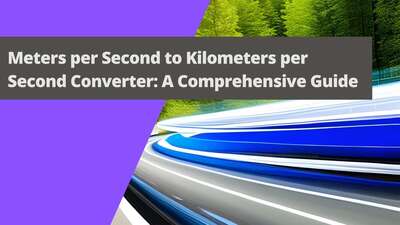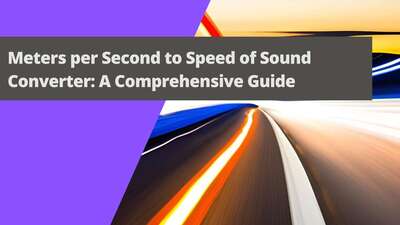Meters Per Second to Miles Per Hour Converter: Your Ultimate Guide

- Introduction: Why Meters Per Second and Miles Per Hour Matter
- Definition: Meters Per Second and Miles Per Hour
- Formula: Converting Meters Per Second to Miles Per Hour
- Explaining the Conversion Factors and Table
- Step-by-Step Guide: How to Convert Meters Per Second to Miles Per Hour
- Real-world Examples and Applications
- Frequently Asked Questions
- Conclusion
In today's fast-paced world, understanding different units of speed is essential. One such conversion that often comes up is from meters per second to miles per hour. In this comprehensive guide, we'll explore the definitions, formulas, conversion factors, and step-by-step processes to convert these units. Plus, we'll provide real-world examples, a helpful table, and answer some frequently asked questions.
Introduction: Why Meters Per Second and Miles Per Hour Matter
Both meters per second (m/s) and miles per hour (mph) are crucial for expressing speed in various contexts, such as transportation, sports, and weather. While meters per second is more commonly used in scientific applications, miles per hour is the preferred unit for everyday use in countries like the United States and the United Kingdom. Knowing how to convert between these units can be helpful in understanding and comparing speeds across different domains.
Definition: Meters Per Second and Miles Per Hour
Meters per second (m/s) is the International System of Units (SI) unit for speed. It describes the distance, in meters, traveled in one second. It is widely used in physics, engineering, and various scientific fields.
Miles per hour (mph) is a unit of speed used primarily in the United States, the United Kingdom, and their territories. It represents the distance, in miles, traveled in one hour. This unit is more familiar to the general public and is often used for road speed limits, vehicle performance, and weather reports.
Formula: Converting Meters Per Second to Miles Per Hour
The formula for converting meters per second to miles per hour is as follows:
mph = m/s * 2.23694
Here, we multiply the speed in meters per second (m/s) by the conversion factor 2.23694 to obtain the equivalent speed in miles per hour (mph).
Explaining the Conversion Factors and Table
The conversion factor 2.23694 is derived from the relationship between meters and miles, as well as seconds and hours. There are 1,609.344 meters in a mile and 3,600 seconds in an hour. Using these relationships, we can calculate the conversion factor:
(1 mile / 1,609.344 meters) * (3,600 seconds / 1 hour) ≈ 2.23694
For convenience, we have prepared a conversion table below:
| Meters per Second (m/s) | Miles per Hour (mph) |
|---|---|
| 1 | 2.23694 |
| 2 | 4.47388 |
| 5 | 11.1847 |
| 10 | 22.3694 |
| 15 | 33.5541 |
You can also use the online speed converter for quick and easy conversions between various speed units, including meters per second and miles per hour.
Step-by-Step Guide: How to Convert Meters Per Second to Miles Per Hour
Follow these simple steps to convert meters per second (m/s) to miles per hour (mph):
- Identify the speed in meters per second (m/s) that you want to convert.
- Multiply the m/s value by the conversion factor 2.23694.
- The result will be the equivalent speed in miles per hour (mph).
For a more detailed guide on converting meters per second, visit this comprehensive guide.
Real-world Examples and Applications
Converting between meters per second and miles per hour can be useful in various real-world scenarios:
- Weather reports: Wind speeds are often measured in meters per second, but people may be more familiar with miles per hour. Converting wind speeds can help make weather forecasts more understandable.
- Sports: In sports like running or cycling, athletes' speeds are sometimes measured in meters per second. Knowing the equivalent speed in miles per hour can help compare performances and set goals.
- Transportation: Trains and planes may have their speeds measured in meters per second for scientific purposes. Converting these speeds to miles per hour can provide a better sense of how fast they are moving relative to everyday experiences.
For additional examples and applications, check out this YouTube playlist.
Frequently Asked Questions
Conclusion
Understanding how to convert between meters per second and miles per hour is essential in various applications, from weather reporting to transportation and sports. With the help of the conversion formula and factor, you can easily switch between these units of speed to better comprehend and communicate information in different contexts. Utilize online speed converters and resources like this guide to make the process even more straightforward. Happy converting!









